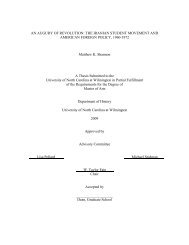HIERARCHAL INDUCTIVE PROCESS MODELING AND ANALYSIS ...
HIERARCHAL INDUCTIVE PROCESS MODELING AND ANALYSIS ...
HIERARCHAL INDUCTIVE PROCESS MODELING AND ANALYSIS ...
You also want an ePaper? Increase the reach of your titles
YUMPU automatically turns print PDFs into web optimized ePapers that Google loves.
Using the exogenous variables time-series we estimate:<br />
0.009868042 ≤<br />
[<br />
]<br />
(1 − E ice (t)) ∗ a 0 ∗ e (0.06933∗E T H 2 O(t))<br />
≤ 0.6060888 (25)<br />
Using (24), (37) and dropping the subtracted elements we find the upper bound to<br />
be,<br />
We may rewrite as follow,<br />
dP<br />
[<br />
]<br />
dt ≤ (0.6060888)(1)(1 − a 6 ) − (a 9 + a 19 ) P<br />
} {{ }<br />
α u<br />
For the lower bound, since (24) and (23):<br />
dP<br />
≤ α<br />
dt u P where α u = 0.4720906<br />
We may rewrite as follow,<br />
dP<br />
dt ≥ − (a 9 + a 19 ) P − a<br />
} {{ } 13 K<br />
α l<br />
dP<br />
dt<br />
≥ −α l P − K<br />
where α l = 0.032101<br />
Using proposition 1 we get,<br />
∴ (P 0 + K α l<br />
)e −α lt − K α l<br />
≤ P (t) ≤ P 0 e αut (26)<br />
P (t) > 0 ∈ (0, +∞)<br />
50
















